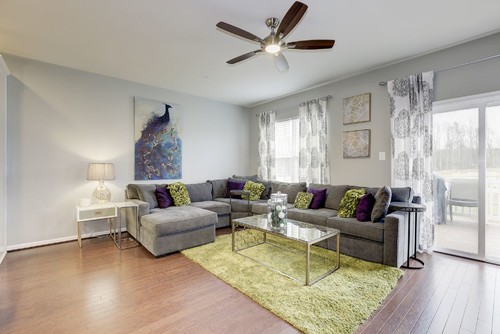There are many ways to cool a home during the summer, however some ways are more energy efficient and budget friendly than others.
Before the heat of summer becomes brutally hot, consider using one or more of the options below to cool your home in the summer.
 photo courtesy of Bill Wilson flickr.com/photos/okchomeseller/29110417171/Open the windows
photo courtesy of Bill Wilson flickr.com/photos/okchomeseller/29110417171/Open the windows
Open windows on either side of a room in order to create cross ventilation.
Just opening one window will not allow the air to flow through your home, so you must open windows on opposite sides of your home or room to get most of the hot air out of your home.
The breeze from outside will run through your home making it feel cooler.
You can even put a box fan in the window to blow more fresh air throughout your home.
Use fans
Fans make a room feel cooler.
You can use a portable fan, a ceiling fan, or any other fan.
Ceiling fans also work at distributing warm air during the winter.
The cost of a moderately priced ceiling fan will often pay for itself within a year by reducing the amount of energy required to make a home feel cooler during the summer and warmer during the winter.
Add an air conditioner
Consider adding a central air conditioning system, a mini split air conditioning system #ad (similar to a hotel room), or a window air conditioning unit.
Make sure to keep your air conditioner in good condition for optimum performance.
If you have a central air conditioner, consider having yearly maintenance done by a professional to make sure all parts are functioning to their best ability.
Don't forget to change your air filters regularly to allow proper air flow.
Reduce Humidity
If you live in a humid climate, the humidity will make you feel warmer.
Consider purchasing a dehumidifier to reduce the humidity in your home.
There are even dehumidifiers that have a hose attached #ad so the humidity can go directly to a sink, which is a great option so you don't have to remember to empty the holding tank. This is also great for when you are not home for extended periods of time so the tank does not fill up and the dehumidifier shut off.
Make sure to run your bathroom vent fan the entire time someone is taking a shower and for 20 minutes after the water is turned off to reduce humidity in your home and keep items in your bathroom from rusing.
Create shade
Shade your home, especially the windows.
To create shade, you can plant a tree or several trees (get deciduous trees that lose their leaves during the winter so the sun's heat can warm your home during the winter), add solar screens #ad or window tint #ad to your windows, use blackout curtains #ad on your windows, or add an awning or pergola.
Also shade your outside air conditioning unit.
You might also like the article How to Make Your Windows More Energy Efficient.
Insulate your home
Keep hot air from getting inside your home by making sure it is well insulated.
You can use spray insulation or other sealant to fill any air gaps.
Ensure that your attic insulation is still at appropriate levels since it will flatten and become less effective over time.
Make sure there are adequate air vents in your attic to let the hot air out.
Consider getting your attic ceiling sprayed with insulating paint.
You can even replace old single paned windows with more energy efficient windows that are more insulated.
Consider getting an energy audit of your home to find opportunities to make your home more energy efficient, make your home more comfortable, and save money over time.
You might also like the article How to Save Money by Making Your Home More Energy Efficient.



